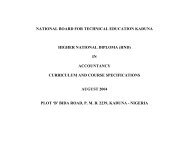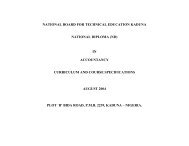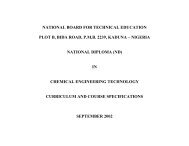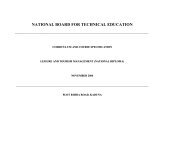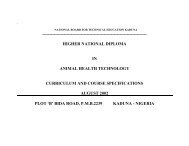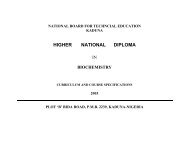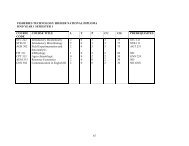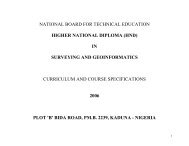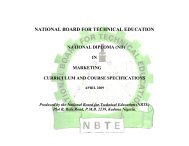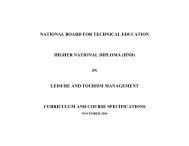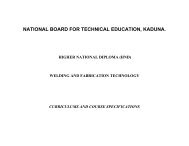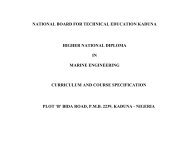bld 105 workshop practice 1 - Yaba College of Technology
bld 105 workshop practice 1 - Yaba College of Technology
bld 105 workshop practice 1 - Yaba College of Technology
You also want an ePaper? Increase the reach of your titles
YUMPU automatically turns print PDFs into web optimized ePapers that Google loves.
PROGRAMME: NATIONAL DIPLOMA IN INTERIOR DESIGN<br />
COURSE NAME: WORKSHOP PRACTICE 1<br />
COURSE CODE: BLD <strong>105</strong><br />
DURATION: 0–4– 4<br />
UNITS: 4 UNIT<br />
GOAL: Introduces the student to the essential principles <strong>of</strong> Building Construction<br />
GENERAL OBJECTIVES: On completion <strong>of</strong> this module the trainee will be able to:<br />
1. Know blocklaying and Concreting Tools, equipment and their uses and maintenance<br />
Procedure<br />
2. Understand Factory Acts and Safety regulations Applicable in the blocklaying and<br />
concreting <strong>workshop</strong><br />
3. Know blocks and concrete materials.<br />
4. Understand the various methods <strong>of</strong> block & Bricklaying and concreting<br />
5. Know different types <strong>of</strong> brick and block walls and their types <strong>of</strong> bonds
PROGRAMME: NATIONAL DIPLOMA IN ARCHITECTURAL TECHNOLOGY<br />
COURSE:WORKSHOP PRACTICE 1 BLD <strong>105</strong> CONTACT HOURS : 0-0-4<br />
GOAL:<br />
Course Specification; Theoretical Content Practical Content<br />
General Objective: General Objective<br />
General Objective 1.0: Know blocklaying and Concreting Tools, equipment and their uses and<br />
maintenance Procedure<br />
Week Specific<br />
Learning<br />
1<br />
2<br />
Objectives<br />
Teachers<br />
Activities<br />
Learning<br />
Resources<br />
Specific Learning Objectives Teachers Activities Learning Resources<br />
1.1 Select bricklaying and<br />
concreting tools and equipment such<br />
as blocklaying trowel, pointing trowel,<br />
spirit level, builders square, straight<br />
edge (range), wooden float, concrete<br />
mixers, vibrators, concrete forms,<br />
and block moulding machines for<br />
specific job requirements.<br />
1.2 Use the tools and equipment in<br />
1.1 above. Maintain the tools and<br />
equipment in 1.1 above select,<br />
cutting and plastering tools such as<br />
club hammer, bolster chisel, cold<br />
chisel, brick saw; and hark saw for<br />
specific job requirements<br />
1.1 Select bricklaying and concreting<br />
tools and equipment such as<br />
blocklaying trowel, pointing trowel,<br />
spirit level, builders square, straight<br />
edge (range), wooden float, concrete<br />
mixers, vibrators, concrete forms,<br />
and block moulding machines for<br />
specific job requirements.<br />
1.2 Use the tools and equipment in<br />
1.1 above. Maintain the tools and<br />
equipment in 1.1 above select,<br />
cutting and plastering tools such as<br />
club hammer, bolster chisel, cold<br />
chisel, brick saw; and hark saw for<br />
Demonstrate the use <strong>of</strong> various<br />
bricklaying and concreting<br />
tools.<br />
Demonstrate the use <strong>of</strong> cutting<br />
and plastering tools.<br />
Demonstrate maintenance <strong>of</strong><br />
the tools<br />
Demonstrate the use <strong>of</strong> various<br />
bricklaying and concreting<br />
tools.<br />
Demonstrate the use <strong>of</strong> cutting<br />
and plastering tools.<br />
Demonstrate maintenance <strong>of</strong><br />
the tools<br />
Workshop tools and<br />
equipment. Different trowels,<br />
spirit level, builders square,<br />
straight edge (range),<br />
wooden float, concrete<br />
mixers, vibrators, concrete<br />
forms, block moulding<br />
machine and consumables,<br />
Cutting and plastering tools.<br />
Workshop tools and<br />
equipment. Different trowels,<br />
spirit level, builders square,<br />
straight edge (range),<br />
wooden float, concrete<br />
mixers, vibrators, concrete<br />
forms, block moulding<br />
machine and consumables,<br />
Cutting and plastering tools.
3<br />
specific job requirements<br />
1.1 Select bricklaying and concreting Demonstrate the use <strong>of</strong> various Workshop tools and<br />
tools and equipment such as bricklaying and concreting equipment. Different trowels,<br />
blocklaying trowel, pointing trowel, tools.<br />
spirit level, builders square,<br />
spirit level, builders square, straight<br />
straight edge (range),<br />
edge (range), wooden float, concrete Demonstrate the use <strong>of</strong> cutting wooden float, concrete<br />
mixers, vibrators, concrete forms, and plastering tools.<br />
mixers, vibrators, concrete<br />
and block moulding machines for<br />
forms, block moulding<br />
specific job requirements.<br />
Demonstrate maintenance <strong>of</strong> machine and consumables,<br />
1.2 Use the tools and equipment in<br />
1.1 above. Maintain the tools and<br />
equipment in 1.1 above select,<br />
cutting and plastering tools such as<br />
club hammer, bolster chisel, cold<br />
chisel, brick saw; and hark saw for<br />
specific job requirements<br />
the tools<br />
Cutting and plastering tools.<br />
General Objective 2.0: Understand Factory Acts and Safety regulations Applicable in the<br />
blocklaying and concreting <strong>workshop</strong><br />
Week Specific Learning Objectives Teachers Activities Learning Resources<br />
4 2.1 Choose adequate ventilation for<br />
the <strong>workshop</strong><br />
2.2 Create safe storage <strong>of</strong> tools and<br />
first aid equipment<br />
2.3 Demonstrate general safety<br />
habits with respect to the equipment<br />
2.4 Demonstrate the layout <strong>of</strong> an<br />
ideal blocklaying and concreting<br />
<strong>workshop</strong><br />
5 2.1 Choose adequate ventilation for<br />
the <strong>workshop</strong><br />
2.2 Create safe storage <strong>of</strong> tools and<br />
first aid equipment<br />
2.3 Demonstrate general safety<br />
habits with respect to the equipment<br />
2.4 Demonstrate the layout <strong>of</strong> an<br />
ideal blocklaying and concreting<br />
<strong>workshop</strong><br />
6 2.1 Choose adequate ventilation for<br />
the <strong>workshop</strong><br />
2.2 Create safe storage <strong>of</strong> tools and<br />
first aid equipment<br />
2.3 Demonstrate general safety<br />
Demonstrate how to create<br />
safe storage <strong>of</strong> tools and first<br />
aid equipment.<br />
Demonstrate how to layout<br />
block laying and concreting<br />
<strong>workshop</strong>.<br />
Demonstrate how to create<br />
safe storage <strong>of</strong> tools and first<br />
aid equipment.<br />
Demonstrate how to layout<br />
block laying and concreting<br />
<strong>workshop</strong>.<br />
Demonstrate how to create<br />
safe storage <strong>of</strong> tools and first<br />
aid equipment.<br />
Demonstrate how to layout<br />
Workshop and consumables<br />
Workshop and consumables<br />
Workshop and consumables
habits with respect to the equipment<br />
2.4 Demonstrate the layout <strong>of</strong> an<br />
ideal blocklaying and concreting<br />
<strong>workshop</strong><br />
block laying and concreting<br />
<strong>workshop</strong>.<br />
General Objective 3.0: Know blocks and concrete materials.<br />
Week Specific Learning Objectives Teachers Activities Learning Resources<br />
7 3.1 Differentiate between various<br />
types <strong>of</strong> fine aggregates, coarse<br />
aggregate, blocks, concrete and<br />
additives.<br />
3.2 Illustrate types <strong>of</strong> concrete<br />
products<br />
3.3 Select suitable aggregates for<br />
different kinds <strong>of</strong> construction works.<br />
3.4 Carry out various tests on blocks<br />
and concrete material.<br />
8 3.1 Differentiate between various<br />
types <strong>of</strong> fine aggregates, coarse<br />
aggregate, blocks, concrete and<br />
additives.<br />
3.2 Illustrate types <strong>of</strong> concrete<br />
products<br />
3.3 Select suitable aggregates for<br />
different kinds <strong>of</strong> construction works.<br />
3.4 Carry out various tests on blocks<br />
and concrete material.<br />
9 3.1 Differentiate between various<br />
types <strong>of</strong> fine aggregates, coarse<br />
aggregate, blocks, concrete and<br />
additives.<br />
3.2 Illustrate types <strong>of</strong> concrete<br />
products<br />
3.3 Select suitable aggregates for<br />
different kinds <strong>of</strong> construction works.<br />
3.4 Carry out various tests on blocks<br />
and concrete material.<br />
10 3.1 Differentiate between various<br />
types <strong>of</strong> fine aggregates, coarse<br />
aggregate, blocks, concrete and<br />
additives.<br />
3.2 Illustrate types <strong>of</strong> concrete<br />
products<br />
3.3 Select suitable aggregates for<br />
Show different types <strong>of</strong> fine and<br />
coarse aggregates, blocks,<br />
concrete and additives.<br />
Show how to carry out tests on<br />
blocks and concrete<br />
Show different types <strong>of</strong> fine and<br />
coarse aggregates, blocks,<br />
concrete and additives.<br />
Show how to carry out tests on<br />
blocks and concrete<br />
Show different types <strong>of</strong> fine and<br />
coarse aggregates, blocks,<br />
concrete and additives.<br />
Show how to carry out tests on<br />
blocks and concrete<br />
Show different types <strong>of</strong> fine and<br />
coarse aggregates, blocks,<br />
concrete and additives.<br />
Show how to carry out tests on<br />
blocks and concrete<br />
Workshop and consumables<br />
e.g. sand, gravel, cement and<br />
additives<br />
Workshop and consumables<br />
e.g. sand, gravel, cement and<br />
additives<br />
Workshop and consumables<br />
e.g. sand, gravel, cement and<br />
additives<br />
Workshop and consumables<br />
e.g. sand, gravel, cement and<br />
additives
different kinds <strong>of</strong> construction works.<br />
3.4 Carry out various tests on blocks<br />
and concrete material.<br />
General Objective 4.0: Understand the various methods <strong>of</strong> block & Bricklaying and concreting<br />
Week Specific Learning Objectives Teachers Activities Learning Resources<br />
11 4.1 Lay blocks <strong>of</strong> various types and<br />
sizes<br />
4.2 Lay wet concrete for simple<br />
slabs, beams and lintels.<br />
4.3 Carry out various ways <strong>of</strong><br />
vibrating, finishing and curing<br />
concrete<br />
12 4.1 Lay blocks <strong>of</strong> various types and<br />
sizes<br />
4.2 Lay wet concrete for simple<br />
slabs, beams and lintels.<br />
4.3 Carry out various ways <strong>of</strong><br />
vibrating, finishing and curing<br />
concrete<br />
13 4.1 Lay blocks <strong>of</strong> various types and<br />
sizes<br />
4.2 Lay wet concrete for simple<br />
slabs, beams and lintels.<br />
4.3 Carry out various ways <strong>of</strong><br />
vibrating, finishing and curing<br />
concrete<br />
Demonstrate how to lay<br />
blocks <strong>of</strong> various types and<br />
sizes.<br />
Demonstrate how to cast<br />
concrete slabs beams and<br />
lintels<br />
Demonstrate various ways <strong>of</strong><br />
vibrating, finishing and curing<br />
concrete<br />
Demonstrate how to lay<br />
blocks <strong>of</strong> various types and<br />
sizes.<br />
Demonstrate how to cast<br />
concrete slabs beams and<br />
lintels<br />
Demonstrate various ways <strong>of</strong><br />
vibrating, finishing and curing<br />
concrete<br />
Demonstrate how to lay<br />
blocks <strong>of</strong> various types and<br />
sizes.<br />
Demonstrate how to cast<br />
concrete slabs beams and<br />
lintels<br />
Demonstrate various ways <strong>of</strong><br />
vibrating, finishing and curing<br />
concrete<br />
Workshop and consumables<br />
e.g. blocks, cement, gravel<br />
sand etc.<br />
Workshop and consumables<br />
e.g. blocks, cement, gravel<br />
sand etc.<br />
Workshop and consumables<br />
e.g. blocks, cement, gravel<br />
sand etc.<br />
General Objective 5.0: Know different types <strong>of</strong> brick and block walls and their types <strong>of</strong> bonds<br />
Week Specific Learning Objectives Teachers Activities Learning Resources<br />
14 5.1 Construct various types <strong>of</strong> bonds<br />
in a block work and brickwork.<br />
5.2 Construct block walls <strong>of</strong> different<br />
thickness.<br />
15 5.1 Construct various types <strong>of</strong> bonds<br />
in a block work and brickwork.<br />
5.2 Construct block walls <strong>of</strong> different<br />
thickness.<br />
Demonstrate how to construct<br />
various types <strong>of</strong> bonds in a<br />
block work and brick work.<br />
Engage students to construct<br />
Demonstrate how to construct<br />
various types <strong>of</strong> bonds in a<br />
block work and brick work.<br />
Engage students to construct<br />
Workshop and consumables<br />
e.g. blocks, bricks etc.<br />
Workshop and consumables<br />
e.g. blocks, bricks etc.
References:<br />
1. Obande Bricklaying and Concreting Longman<br />
2. Kienlighter, C. E. modern masory brick, block, store<br />
ASSESSMENT STRUCTURE<br />
TYPE OF ASSESSMENT PURPOSE AND NATURE OF ASSESSMENT (ITD ) WEIGHING<br />
Examination Final Examination (written) to assess knowledge and understanding 40%<br />
Coursework Continuous assessment At least 5 home works to be assessed by the teacher 20%<br />
Test At least 2 progress tests for feedback. 20%<br />
Practical Works to be assessed by the teacher 20%<br />
TOTAL WEIGHT 100



